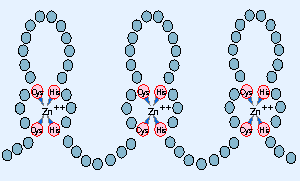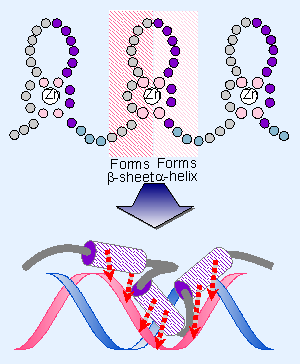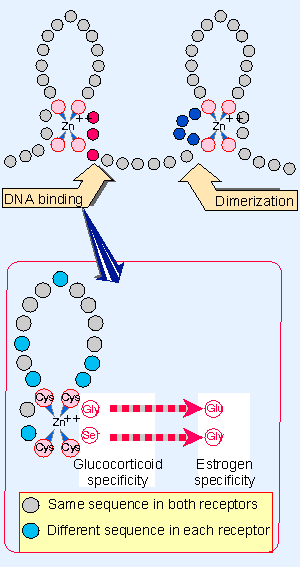4. A zinc finger motif is a DNA-binding domain
21.4 A zinc finger motif is a DNA-binding domain |
 |
Figure 21.3 Transcription factor SP1 has a series of three zinc fingers, each with a characteristic pattern of cysteine and histidine residues that constitute the zinc-binding site. |
Zinc fingers take their name from the structure illustrated in Figure 21.3, in which a small group of conserved amino acids binds a zinc ion, and forms a relatively independent domain in the protein. Two types of DNA-binding proteins have structures of this type: the classic "zinc finger" proteins; and the steroid receptors.
A "finger protein" typically has a series of zinc fingers, as depicted in the figure. The consensus sequence of a single finger is:
Cys-X2-4-Cys-X3-Phe-X5-Leu-X2-His-X3-His
The motif takes its name from the loop of amino acids that protrudes from the zinc-binding site and is described as the Cys2/His2 finger. The zinc is held in a tetrahedral structure formed by the conserved Cys and His residues. The finger itself comprises ~23 amino acids, and the linker between fingers is usually 7 V8 amino acids.
Zinc fingers are a common motif in DNA-binding proteins. The fingers usually are organized as a single series of tandem repeats; occasionally there is more than one group of fingers. The stretch of fingers ranges from 9 repeats that occupy almost the entire protein (as in TFIIIA) to providing just one small domain consisting of 2 fingers (as in the Drosophila regulator ADR1). The general transcription factor Sp1 has a DNA-binding domain that consists of 3 zinc fingers (Kadonaga et al., 1987; Miller et al., 1985).
 |
Figure 21.4 Zinc fingers may form a-helices that insert into the major groove, associated with b-sheets on the other side. |
The crystal structure of DNA bound by a protein with three fingers suggests the structure illustrated schematically in Figure 21.4. The C-terminal part of each finger forms α-helices that bind DNA; the N-terminal part forms a β-sheet. (For simplicity, the β-sheet and the location of the zinc ion are not shown in the lower part of the figure.) The three α-helical stretches fit into one turn of the major groove; each α-helix (and thus each finger) makes two sequence-specific contacts with DNA (indicated by the arrows). We expect that the nonconserved amino acids in the C-terminal side of each finger are responsible for recognizing specific target sites (Pavletich and Pabo, 1991).
Knowing that zinc fingers are found in authentic transcription factors that assist both RNA polymerases II and III, we may view finger proteins from the reverse perspective. When a protein is found to have multiple zinc fingers, there is at least a prima facie case for investigating a possible role as a transcription factor. Such an identification has suggested that several loci involved in embryonic development of D. melanogaster are regulators of transcription.
It is necessary to be cautious about interpreting the presence of (putative) zinc fingers, especially when the protein contains only a single finger motif. Fingers may be involved in binding RNA rather than DNA or even unconnected with any nucleic acid binding activity.
The prototype zinc finger protein, TFIIIA, binds both to the 5S gene and to the product, 5S rRNA. A translation initiation factor, eIF2β has a zinc finger; and mutations in the finger influence the recognition of initiation codons. Retroviral capsid proteins have a motif related to the finger that may be involved in binding the viral RNA.
Steroid receptors (and some other proteins) have another type of finger. The structure is based on a sequence with the zinc-binding consensus:
Cys-X2-Cys-X13-Cys-X2-Cys
These are called Cys2/Cys2 fingers. They are distinct from Cys2/His2 fingers. Proteins with Cys2/Cys2 fingers often have nonrepetitive fingers, in contrast with the tandem repetition of the Cys2/His2 type. Binding sites in DNA (where known) are short and palindromic.
The glucocorticoid and estrogen receptors each have two fingers, each with a zinc atom at the center of a tetrahedron of cysteines. The two fingers form α-helices that fold together to form a large globular domain. The aromatic sides of the α-helices form a hydrophobic center together with a β-sheet that connects the two helices. One side of the N-terminal helix makes contacts in the major groove of DNA. Two glucocorticoid receptors dimerize upon binding to DNA, and each engages a successive turn of the major groove. This fits with the palindromic nature of the response element (see later).
 |
Figure 21.5 The first finger of a steroid receptor controls specificity of DNA-binding (positions shown in red); the second finger controls specificity of dimerization (positions shown in blue). The expanded view of the first finger shows that discrimination between GRE and ERE target sequences rests on two amino acids at the base. |
Each finger controls one important property of the receptor. Figure 21.5 identifies the relevant amino acids. Those on the right side of the first finger control binding to DNA; those on the left side of the second finger control the ability to form a dimer (which we discuss in the next section).
Direct evidence that the first finger binds DNA was obtained by a "specificity swap" experiment. The finger of the estrogen receptor was deleted and replaced by the sequence of the glucocorticoid receptor. The new protein recognized the GRE sequence (the usual target of the glucocorticoid receptor) instead of the ERE (the usual target of the estrogen receptor). This region therefore establishes the specificity with which DNA is recognized.
The differences between the sequences of the glucocorticoid receptor and estrogen receptor fingers lie mostly at the base of the finger. The substitution at two positions shown in Figure 21.5 allows the glucocorticoid receptor to bind at an ERE instead of a GRE (for review see Tsai and O'Malley, 1994).
| Reviews | |
| Tsai, M.-J. and O'Malley, B. W. (1994). Molecular mechanisms of action of steroid/thyroid receptor superfamily members. Ann. Rev. Biochem 63, 451-486. | |
| Research | |
| Kadonaga, J. et al. (1987). Isolation of cDNA encoding transcription factor Sp1 and functional analysis of the DNA binding domain. Cell 51, 1079-1090. | |
| Miller, J. et al. (1985). Repetitive zinc binding domains in the protein transcription factor IIIA from Xenopus oocytes. EMBO J. 4, 1609-1614. | |
| Pavletich, N. P. and Pabo, C. O. (1991). Zinc finger-DNA recognition: crystal structure of a Zif268-DNA complex at 21 Å. Science 252, 809-817. | |